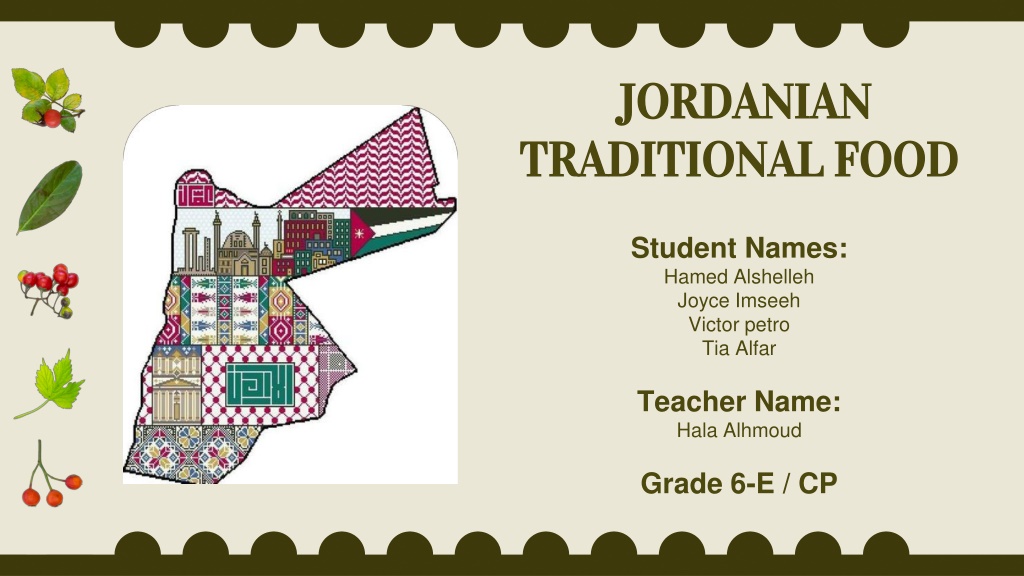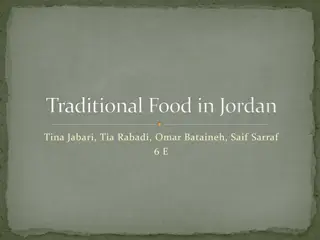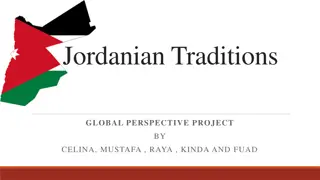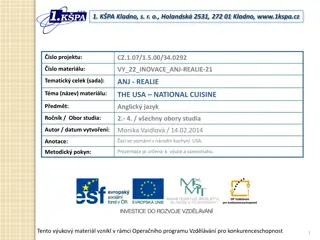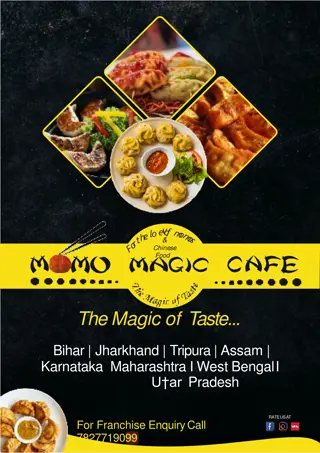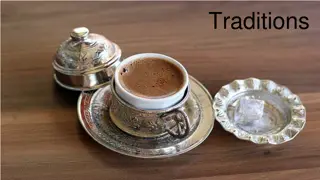Exploring Traditional Jordanian Cuisine: Mansaf, Jameed, and Makmoura
Delve into the rich and diverse culinary heritage of traditional Jordanian cuisine, revealing iconic dishes like Mansaf, the history of Jameed as a fundamental ingredient, and the origins of Makmoura in northern Jordan. Discover the flavors and traditions that make Jordanian cuisine unique and cherished.
Download Presentation

Please find below an Image/Link to download the presentation.
The content on the website is provided AS IS for your information and personal use only. It may not be sold, licensed, or shared on other websites without obtaining consent from the author. Download presentation by click this link. If you encounter any issues during the download, it is possible that the publisher has removed the file from their server.
E N D
Presentation Transcript
JORDANIAN JORDANIAN TRADITIONAL FOOD TRADITIONAL FOOD Student Names: Hamed Alshelleh Joyce Imseeh Victor petro Tia Alfar Teacher Name: Hala Alhmoud Grade 6-E / CP
INTRODUCTION INTRODUCTION Traditional Jordanian cuisine is a rich and diverse culinary heritage, reflecting the country's history, culture, and unique geography. It can be found throughout the country, from the vibrant streets of Amman to the serene deserts of Wadi Rum. It is renowned for delightful dishes like Mansaf, Makmoura, and Sajeyeh, blending the past with the present in a unique way.
Traditional Jordanian Cuisine Traditional Jordanian Cuisine MANSAF MANSAF Origin of Mansaf The history of Jordanian Mansaf is traditionally associated with the city of Karak. Mansaf has a long and rich history in that region. However, it has spread widely throughout Jordan and has become an important part of the national cuisine.
Mansaf Ingredients Meat, Jameed (dried yogurt), rice, Arabic bread, ghee, almonds, and pine nuts. How to Eat Mansaf Mansaf is typically eaten with three fingers of the right hand (the thumb, index finger, and middle finger) or with the whole hand. People often consume Mansaf while standing, and it is preferred to place the left hand behind the back.
Timing for Consuming Mansaf in Jordanian Culture Mansaf is known in Jordanian culture as a traditional lunch or dinner meal and can be enjoyed at any time of the day, often during significant family gatherings or social events.
JAMEED JAMEED Jameed is considerd a foundamental ingredient in the preparation of of mansaf. But what are the best types of Jameed?what is it made from?The best types of Jameed in karak are the ones made from sheep's milk ,although it's also possible to make Jameed from goat's milk.
MAKMOURA MAKMOURA Origin of Makmoura Makmoura is a traditional Jordanian dish among the old, popular, and well- known rural cuisines in the northern regions of Jordan, such as Ramtha, Hawara, and villages north of Irbid. Makmoura Ingredients We prepare Makmoura using flour to prepare the dough, meat with minced onions, and olive oil. It is prepared in multiple layers.
TOMATO FRYER ( TOMATO FRYER (Galayet Galayet Bandora Bandora) ) Origin of Tomato Fryer Tomato Fryer ( galayet bandora) is a distinctive traditional meal that is easy to Cook. This dish is considerd apart of popular Cuisines in many regions, including the Jordan Valley and tomato fryer is traditionally served in Amman, Al-Salt, Irbid, Al- Karak, and Ma'an, where it enjoys great popularity.
Tomato Tomato Frayer Frayer Ingredient Ingredient Ingredients for tomato fryer typically include tomatoes, olive oil, hot pepper, and optionally, onions and garlic according to personal preferences.
SAJEEYAH SAJEEYAH origin of Sajeeyah The provinces of Irbid, Karak, and Wadi Rum are known in Jordan for making "Sajeeyah." Besides these, Sajeeyah can also be found in other Jordanian provinces like Ma'an, Tafilah, Zarqa, Madaba, and Amman.
Sajeeyah Ingredients Sajeeyah ingredients include lamb fat, lamb meat, and onions, with optional vegetables like sweet and hot peppers and tomatoes. It is named "Sajeeyah" due to the deep and large pan it is cooked in. Sajeeyah is a favorite dish for outings, holidays, and all occasions.
JORDANIAN COFFEE JORDANIAN COFFEE Origin of Jordanian Coffee The history of coffee can be traced back to the Bedouins. Jordan's coffee production combines a unique flavor with ancient customs. Jordanian coffee is present in all cities and governorates, from Karak to Amman, and from Jerash to Petra. Ingredients of Jordanian Coffee The components of Jordanian coffee include roasted coffee, cardamom, and water, prepared in a dallah to keep it hot.
Pouring coffee Traditional in Jordanian Culture Pouring coffee Traditional in Jordanian Culture - Holding the dallah with the left hand. - Pouring a small quantity of coffee. - Presenting the cup with the right hand. - Serving coffee from right to left in gatherings. - Serving coffee to the eldest first in gatherings. - Not forgetting any guest. Shaking the cup signal whether you want more or are finished. -
REFERENCES REFERENCES Videos: https://www.youtube.com/wat ch?v=VjHIhvbPRfs Jnon.org 3arf.org archive.org ich.gov.jo tabkh.org https://kohanrishe.net https://www.youtube.com/wat ch?v=p2TsPtamTlI https://www.youtube.com/ watch?v=tUtnC0Z7_1w https://www.youtube.com/wat ch?v=sbhbTw3QWWk
